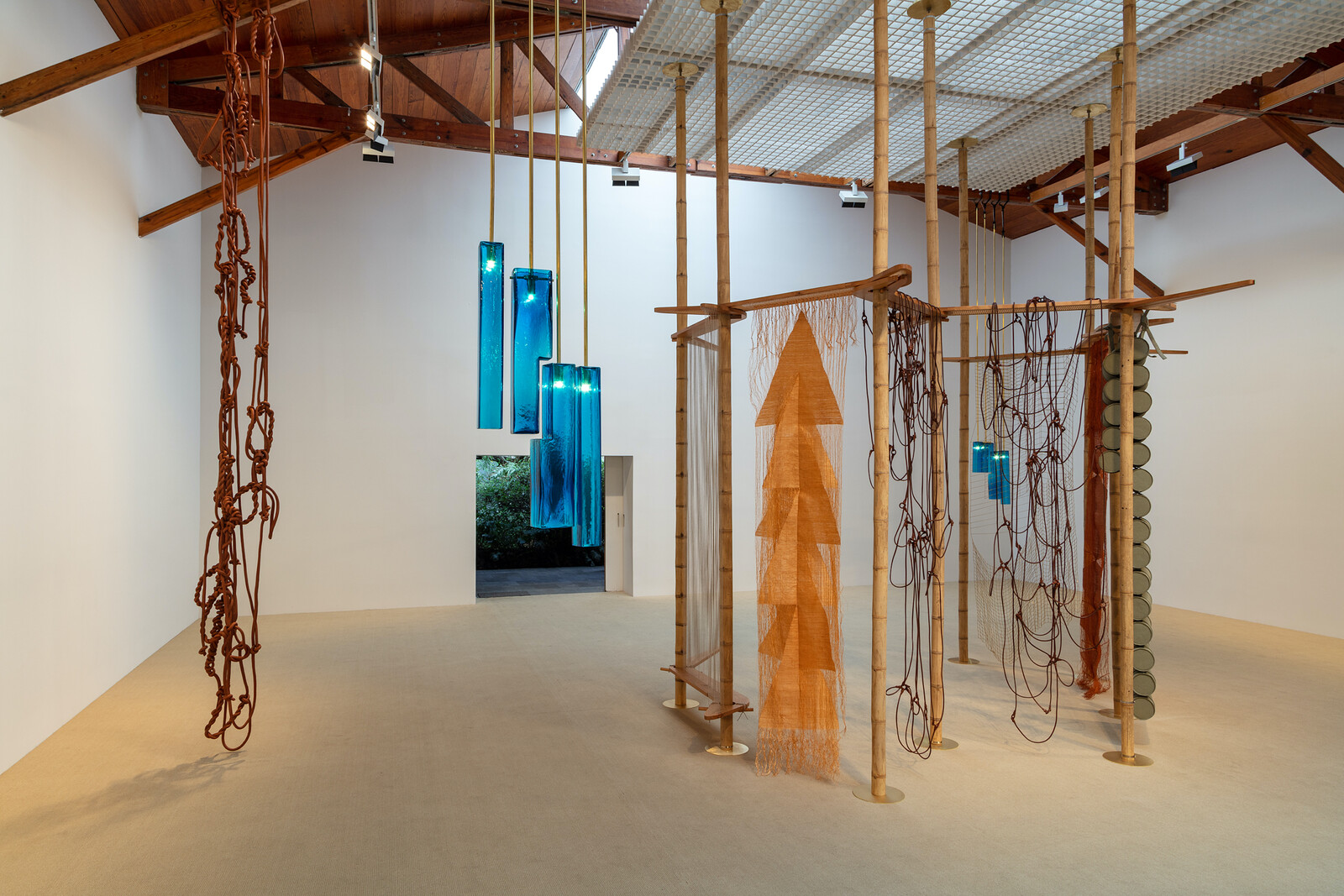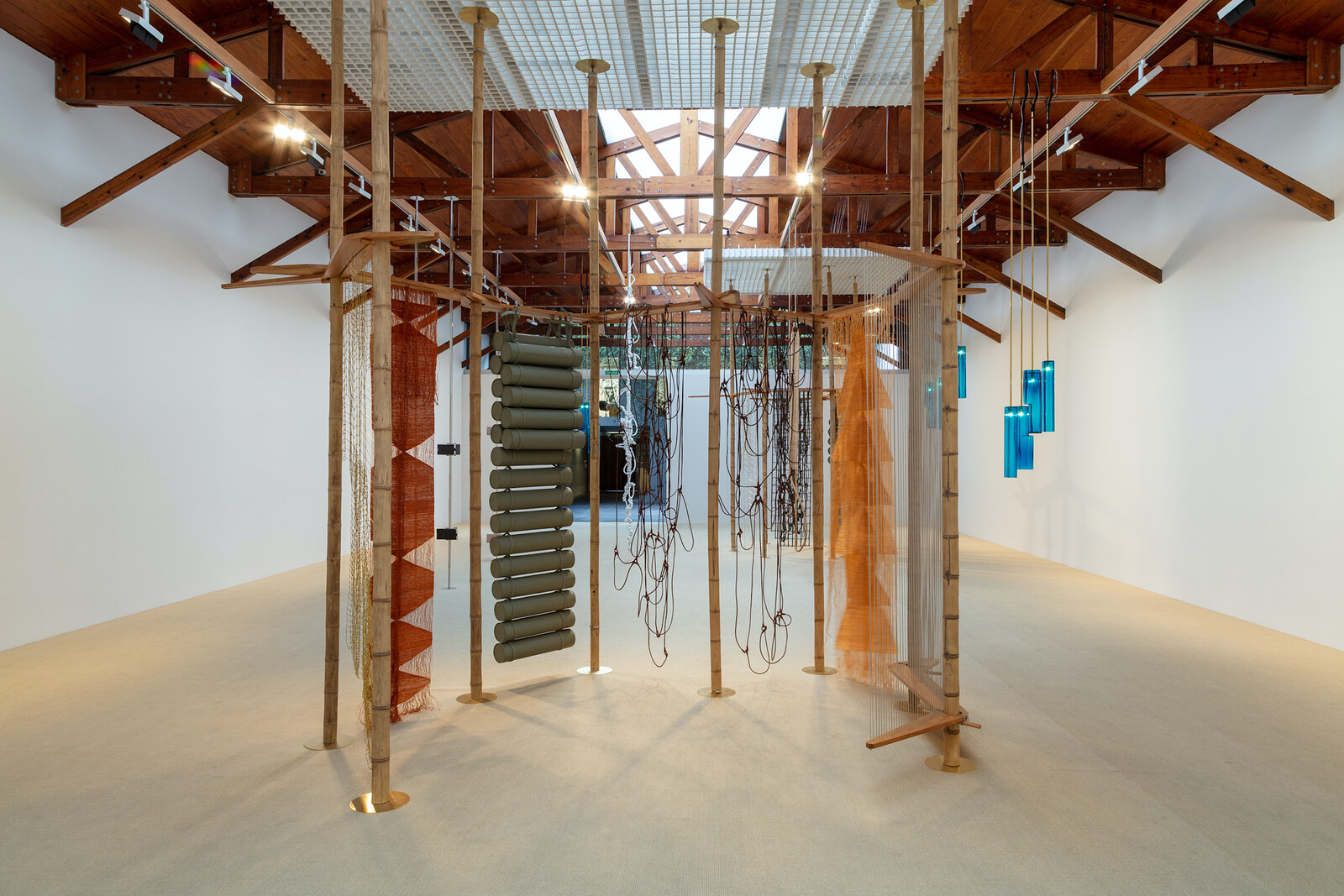February 12–March 19, 2022
Leonor Antunes has described her latest exhibition as a library, or an archive.1 The vast range of materials—jute, bamboo, brass, nylon, pineapple leather, straw silk, cotton, glass—does offer a hanging collection of sorts, presented in various knots, weaves, textiles, and forms of joinery suspended around two primary structures. But any archival capacity is purely speculative, and the exhibition is more a staging of the conceptual possibilities of design than an accounting of historical documents. Nonetheless, histories saturate the work, and the invocation of many elegant lesser-known figures of twentieth-century art and design forms a network of influences tied together by Antunes’s own signature aesthetic.
As in her past work, Antunes addresses local contexts through visual and material citations that are direct, honorary, and respectful, in this case through the figure of Lena Meyer-Bergner, a designer who trained in the second phase of the Bauhaus and moved to Mexico in 1939. She was primarily a textile artist but was active in the graphic workshop, Taller de Gráfica Popular, which was famous for using printmaking to support anti-fascist and leftist political causes. The jute hanging grid that draws influence from Meyer-Bergner’s work tells us little that would recall her legacy directly, but it doesn’t have to. Antunes recognizes material process as history, acknowledging that the refinement of skill is also a form of knowledge transmission. In these transhistorical conversations, she works to resist the forces that canonize some artists and leave others little-studied; her interest in Meyer-Bergner’s work forms part of a decades-long engagement with the underrepresented artists, designers, and architects of modernism.
Another of Antunes’s subjects is French feminist architect and designer Charlotte Perriand, who wrote about domestic space as fundamentally produced by those who inhabit it (in the first half of the twentieth century, read: women). References to Perriand’s formative ideas are thoughtfully embedded: the exhibition’s title is borrowed from her 1936 text of the same name, and the iconic shape of her best-known design, the double chaise longue, is lifted to the ceiling as the wooden structure from which many of the works hang, their discrete forms converging as a single installation. The most dramatic of Antunes’s hanging works, though, are the three knotted ropes suspended directly from kurimanzutto’s wooden beams. She calls these “negotiations,” describing a process of knotting whereby the material becomes an equal determinant in the final form. From a ceiling lift, Antunes works the ropes herself, knotting and twisting them as they hang so that gravity and tension become her material negotiators. Suspended with elegant stasis, they’re among the most technically and aesthetically awe-inspiring of Antunes’s works.
If the rope works appear soaring and structurally ambitious, elsewhere a more intimate effect is achieved: raw silk, dyed in rusty burnt orange, is used to produce delicate, drippy, three-dimensional textiles woven into the rattan hanging structure. Conceptually, this enables Antunes to obtain the difficult goal of spatializing flatness and giving sculptural dimensionality to textiles, surfaces, and substances typically designed to be flat. These are a direct reference to Trude Guermonprez, who was a significant part of the American modernist weaving movement, joining the faculty at Black Mountain College in 1947 at the invitation of Josef and Anni Albers. Her “space hangings” transformed the presentation of weaving from horizontal to vertical and into the realm of suspended sculpture, contributing to discourses on expanded forms of sculpture in space.
Other histories crowd the gallery. Anni Albers, one of Antunes’s frequent transhistorical collaborators, is here in slinky, flowing brass grids. Egle Renata Trincanato, the Italian architect known for her research on Venetian vernacular architecture, is present in the vibrant hanging lamps, whose shapes refer to an unusual brick-wall design by Trincanato. (Antunes collaborated with Murano glassblowers to produce these for the Portugal pavilion at the 2019 Venice Biennale.) And artist Mira Schendel is a longstanding influence on Antunes’s way of working with suspended, voluminous knotted ropes.
Though it’s tempting to find some unifying element in the biographies or domestic experiences of these artists, it’s hardly necessary to read the exhibition that way. The works themselves are stunning material gestures—textured, vibrant, flowing, full of contradictions—and navigating through a space where every sightline is considered, every placement the result of razor-sharp planning, is an antidote for image- and screen-weary eyes. Antunes’s strong aesthetic is the unifying force, as her interests in overlooked legacies bend to her vision through muted palettes and the strength of raw materials. I wish that hers was a more common way to learn (or teach) the unresolved histories of modernism’s material practices.
Leonor Antunes talks about “the homemaker and her domain, part iii” at kurimanzutto, https://www.youtube.com/watch?v=kRJSJSCeBNM.






